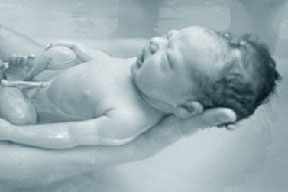|
IVillage Homebirth Board Members Page |
|
|
Waterbirth FAQs "Remember that birth, as a
gift, was not meant to be scary. It was meant to test you, to prepare you for this greater journey of caring for your young.”
Lakshmi Bertram, author of Choosing Waterbirth
Is waterbirth safe? What prevents baby from breathing under water? How
long is baby in the water after the birth? Here in the Physiologically, the placenta
is supporting the baby with oxygen during this time though it can never be predicted when the placenta will begin to separate
causing the flow of oxygen to baby to stop. The umbilical cord pulsating is not a guarantee that the baby is receiving enough
oxygen. The safe approach is to remove the baby, without hurrying, and gently place him into his mother's arms. When should
I get into the water? A woman should be encouraged to use the
labor pool whenever she wants. However, if a mother chooses to get into the water in early labor, before her contractions
are strong and close together, the water may relax her enough to slow or stop labor altogether. That is why some practitioners limit the use of the pool until labor patterns are established and the cervix
is dilated to at least 5 centimeters. Who cleans up after the birth? |
